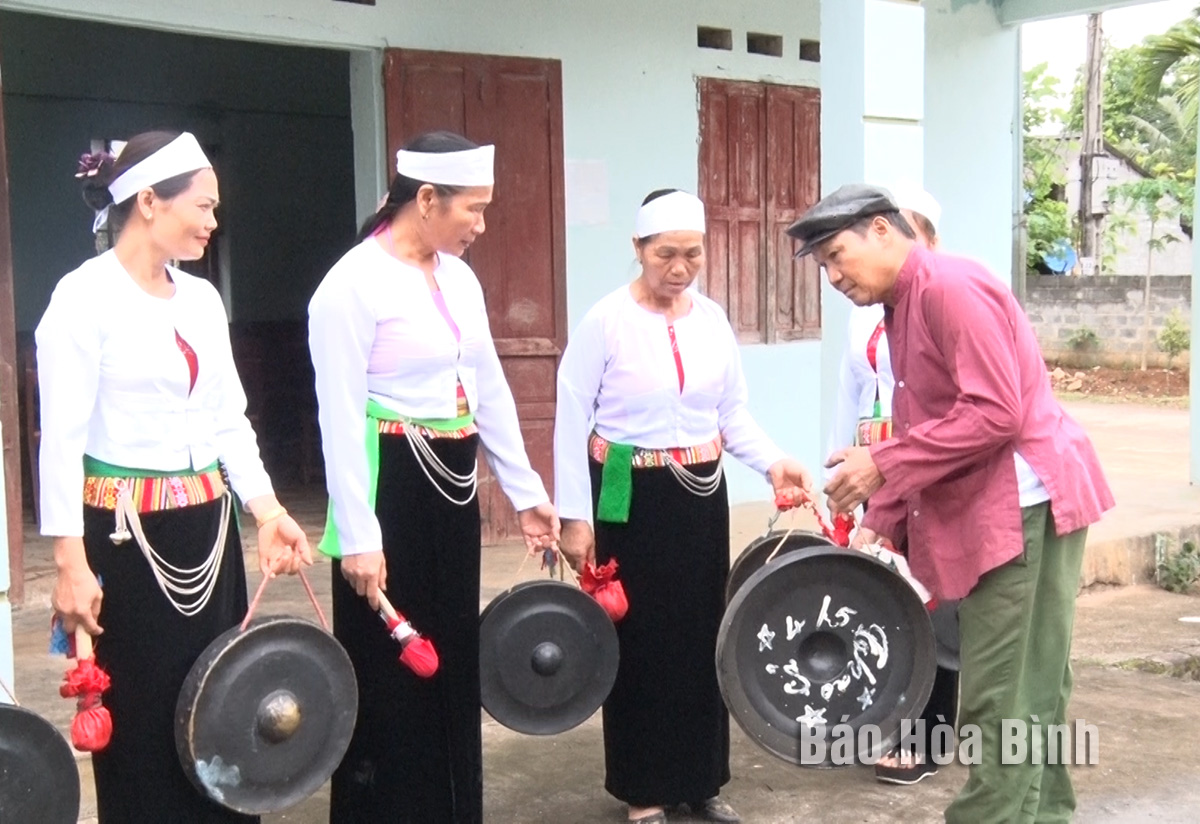
Kim Boi district has worked to preserve and promote the cultural trait of the local Muong ethnic minority group, taking them as a mission to popularise and effectively carry out the Party’s guidelines and the State’s regulations.
Artisan Bui Tien Xo is
instructing members of the Muong gong club in Thao Ca hamlet, Vinh Tien commune
how to play chieng (gong).
The district has directed competent sectors and
branches to enhance communications work to raise public awareness of policies
on preserving and promoting cultural heritage. Besides, it has paid due
attention to safeguarding traditional folk games, honouring artisans, families
and community with standout contributions to the preservation work, and promote
the restoration of traditional festivals such as Muong Dong festival, Lap
communal house festival, and Sim pagoda festival.
The culture and information bureau proposes the
district organise art performance programmes and create traditional cultural
space to preserve and develop the culture.
According to head of the bureau Nguyen Thanh Ha,
a number of practical measures have been rolled out to keep the Muong ethnic
culture alive such as arranging training classes for cultural officials and Mo
Muong artisans, debuting the club to preserve and promote Mo Muong cultural
heritage, and organising contest and festivals.
Besides, the district has listed local
intangible cultural heritage, handed the items on younger generations and
honour artisans, she said, adding the State has bestowed the artisan title on
nine folk artists, including seven Mo Muong, one Muong folk singing and one
Muong gong artist.
Meritorious artisan Bach Thi Dao in Beo hamlet,
Xuan Thuy commune, has had a strong passion for Muong folk songs since she was
a little girl. She established a Muong folk singing and gong club in 2017 with
a view to teaching local kids about the Muong tradition.
Statistics showed that there are 45 shamans in
Kim Boi district who have a great deal of knowledge and a deep insight into the
Mo Muong values. They have conducted Mo Muong rituals in line with current
regulations to preserve and promote its values.
In the coming time, Kim Boi district will
continue communications work to raise public awareness of the preservation of
the traditional values, and encourage communes and town to establish cultural
clubs and honour those who make contributions to safeguarding the local
cultural treasure.
Gongs hold a special place in the cultural and spiritual life of the Muong ethnic people in Hoa Binh province. More than musical instruments, they are an indispensable part of community rituals and collective memory, echoing through generations as a spiritual thread linking the past, present, and future.
Preserving and promoting the cultural values of the Muong ethnic group has become an urgent task in the current context, as many traditional values face the risk of fading away. This effort requires not only protecting the cultural identity but also eliminating outdated customs and developing a modern cultural lifestyle, contributing to sustainable values for the Muong community in Hoa Binh province.
The Muong ethnic culture, deeply rooted in Vietnam’s mountainous north, continues to be preserved and revitalised by dedicated individuals and communities determined to safeguard their ancestral identity.
The Muong group is one of the largest ethnic minorities in Vietnam, primarily found in Hoa Binh province. The Muong people in Hoa Binh boast a rich and diverse cultural treasure that reflects the unique identity of this ethnic group. Accounting for over 63% of the province's population, they have created and preserved numerous distinctive cultural values, contributing to their unique identity. Their cultural heritage is an invaluable asset, at the heart of their national identity, and represents a vibrant spiritual life that must be preserved and promoted in today’s modern world.
For generations, the ethnic communities of Hoa Binh province, particularly the Muong people, have preserved vibrant festivals deeply intertwined with the region’s geography, nature, and social traditions. These celebrations enrich Hoa Binh’s spiritual life and cultural identity, reflecting both folk beliefs and the intermingling of ethnic customs. Many of these festivals have endured the test of time, passed down through generations and continuing to thrive today. Among them, the Khai Ha (Going Down to the Field) festival stands out as one of the most significant events of the Muong ethnic group.
Muong calendar, known as sach doi, is an ancient folk knowledge system developed through observations of the movement of the pleiades star. This unique calendar consists of 12 bamboo sticks, each representing a lunar month. Specific days within each month are marked with distinct symbols, guiding locals in determining auspicious and inauspicious days for important activities.



